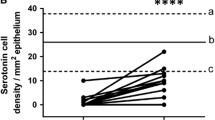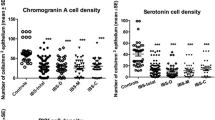Abstract
Background
General disturbances in gastrointestinal motility have been reported in patients with irritable bowel syndrome (IBS). The gastrointestinal tract hormones play an important role in regulating gastrointestinal motility.
Aims
To investigate a possible abnormality in the small intestinal endocrine cells of IBS patients.
Methods
Included in the study were 41 patients with irritable bowel syndrome according to Rome Criteria III and 42 healthy controls. Duodenal biopsies were obtained from both patients and controls during gastroscopy. The biopsies were immunostained by avidin–biotin-complex method for secretin, CCK, GIP, somatostatin, and serotonin cells. The cell densities were quantified by computerized image analysis.
Results
The density of secretin- and CCK-immunoreactive cells in patients with IBS was significantly reduced. The reduction in secretin and CCK cells occurred only in IBS-diarrhea patients, but not in IBS-constipation subtype. Both GIP and somatostatin cell densities were reduced in the duodenum of IBS patients. There was no statistical difference between the subtypes of IBS patients, regarding secretin, CCK, GIP, or somatostatin cell densities. Serotonin cell density was not affected in patients with IBS.
Conclusions
The low densities of secretin and CCK cells in IBS-diarrhea patients may cause a functional pancreatic insufficiency as well as inadequate gall emptying, as these hormones stimulate pancreatic bicarbonate and enzyme secretion and CCK stimulates as well gall bladder contraction. Low densities of secretin, GIP, and somatostatin cells in IBS patients might result in a high secretion of gastric acid, as secretin, GIP, and somatostatin inhibit gastric acid secretion.




Similar content being viewed by others
References
Thompson WG. A world view of IBS. In: Camilleri M, Spiller R, eds. Irritable bowel syndrome: diagnosis and treatment. Philadelphia: Saunders; 2002:17–26.
Agreus L, Svarsudd K, Nygren O, et al. Irritable bowel syndrome and dyspepsia in general population: overlap and lack of stability over time. Gastroenterology. 1995;109:671–680.
Thompson WG, Haeton KW. Functional bowel disorders in apparently healthy people. Gastorenterology. 1980;79:283–288.
Kennedy TM, Jones RH, Hungin AP, et al. Irritable bowel syndrome, gastro-oesophageal reflux, and bronchial hyper-responsiveness in the general population. Gut. 1998;43:770–774.
Drossman DA, Li Z, Andruzzi E, et al. U.S. householder survey of functional gastrointestinal disorders. Prevalence, sociodemography, and health impact. Dig Dis Sci. 1993;38:1569–1580.
Talley NJ, Gabriel SE, Harmsen WS, et al. Medical costs in community subjects with irritable bowel syndrome. Gastroenterology. 1995;109:1736–1741.
Hugin AP, Whonwell PJ, Tack J, et al. The prevalence, patterns and impact of irritable bowel syndrome: an international survey of 40,000 subjects. Alment Pharmacol Ther. 2003;17:643–650.
Jones R, Lydeard S. Irritable bowel syndrome in the general population. BMJ. 1992;304:87–90.
Bordie AK. Functional disorders of the colon. J Indian Med Assoc. 1972;58:451–456.
O`Keefe EA, Talley NJ, Zinsmeister AR, et al. Bowel disorders impair functional status and quality of life in the elderly: a population-based study. J Biol Sci Med Sci. 1995;50:M184–M189.
Everhart JE, Renault PF. Irritable bowel syndrome in office-based practice in the United States. Gastroenterology. 1991;100:998–1005.
Wilson S, Roberts L, Roalfe A, et al. Prevalence of irritable bowel syndrome: a community survey. Br J Gen Pract. 2004;54:495–502.
Harvey RF, Salih SY, Read AE. Organic and functional disorders in 2000 gastroenterology outpatients. Lancet. 1983;1:632–634.
Spiegel BM. The burden of IBS: looking at metrics. Curr Gastroenterol Rep. 2009;11:265–269.
Whitehead WE, Burnett CK, Cook EW III, et al. Impact of irritable bowel syndrome on quality of life. Dig Dis Sci. 1996;41:2248–2253.
Gralnek IM, Hays RD, Kilbourne A, et al. The impact of irritable bowel syndrome on health related quality of life. Gastroenterology. 2000;11:654–660.
Huerta-Icelo I, Hinojosa C, Santa Maria A, et al. Diferencias en la calidad de vida (CV) entre pacientes con sindrome de Intestino irritable (SII) y la poblacon mexicana evaluadas mediante el SF-36. Rev Mex Gastroenterol. 2001;66(Suppl 2):145–146.
Schmulson M, Robles G, Kershenobich D, et al. Los pacientes con trastornos funcionales digestivos (TFD) tienen major compromiso de la calidad de vida (CV) evaluadas por el SF-36 comparados con pacientes con hepatitis C y pancreatitis cronica. Rev Mex Gastroenterol. 2000;65(Suppl-Resumenes):50–51.
Whorwell PJ, Clouter C, Smith CL. Oesophagus motility in the irritable bowel syndrome. BMJ. 1981;282:1101–1102.
Caballero-Plasencia AM, Valenzula-Barranco M, Herrerias-Gutierrez JM, et al. Altered gastric emptying in patients with irritable bowel syndrome. Eur Nul Med. 1999;26:404–409.
Evans PR, Bak YT, Shuter B, et al. Gastroparesis and small bowel dysmotility in irritable bowel syndrome. Dig Dis Sci. 1997;42:2087–2093.
van Wijk HJ, Smout AJ, Akkerman LM, et al. Gastric emptying and dyspeptic symptoms in irritable bowel syndrome. Scand J Gastroenterol. 1992;27:99–102.
Cann PA, Read NW, Brown C, et al. Irritable bowel syndrome: relation of disorders in the transit of single solid meal top symptom patterns. Gut. 1983;24:405–411.
Kellow JE, Philips SF. Altered small bowel motility in irritable bowel syndrome is correlated with symptoms. Gastroenterology. 1987;92:1885–1893.
Kellow JE, Philips SF, Miller LJ, et al. Dysmotility of the small bowel in irritable bowel syndrome. Gut. 1988;29:1236–1243.
El-Salhy M. Gut neuroendocrine system in diabetes gastroenteropathy: possible role in pathophysiology and clinical implications. In: Ford AM, ed. Focus on diabetes mellitus research. New York: Nova Science Publishers; 2006:79–102.
Lee KJ, Kim JH, Kwon HC, et al. The alteration of enterochromaffin cells, mast cells, and Lamnia propria T lymphocyte numbers in irritable bowel syndrome and its relation with psychological factors. J Gastroenterol Hepatol. 2008;23:1689–1694.
Wang SH, Dong L, Luo JY, et al. Decreased expression of serotonin in the jejunum and increased numbers of mast cells in the terminal ileum in patients with irritable bowel syndrome. World J Gastroenterol. 2007;13:6041–6047.
Spiller RC, Jenkins D, Thornley JP, et al. Increased rectal mucosal enteroendocrine cells, T lymphocytes, and increased gut permeability following acute Campylobacter enteritis and in post-dysenteric irritable bowel syndrome. Gut. 2000;47:804–811.
Wheatcroft J, Wakelin D, Smith A, et al. Enterochromaffin cell hyperplasia and decreased serotonin transporter in mouse model of postinfectious bowel dysfunction. Neurogastroenterol Motil. 2005;17:863–870.
Dunlop SP, Jenkins D, Neal KR, et al. Relative importance of enterochromaffin cell hyperplasia, anxiety, and depression in postinfectious IBS. Gastroenterology. 2003;125:1651–1659.
Park JH, Rhee P-L, Kim G, et al. Enteroendocrine cell counts correlated with visceral hypersensitivity in patients with diarrhoea-predominant irritable bowel syndrome. Neurogastroenterol Motil. 2006;18:539–546.
Van Der Veek PP, Biemond I, Masclee AA. Proximal and distal gut hormone secretion in irritable bowel syndrome. Scand J Gastroenterol. 2006;41:170–177.
El-Salhy M, Stenling R, Grimelius L. Peptidergic innervation and endocrine cells in the human liver. Scand J Gastroenterol. 1993;28:809–815.
Sandström O, El-Salhy M. Aging and endocrine cells of human duodenum. Mech Ageing Develop. 1999;108:39–48.
El-Salhy M, Norrgård Ö, Spinnell S. Abnormal colonic endocrine cells in patients with chronic idiopathic slow-transit constipation. Scand J Gastroenterol. 1999;34:1007–1011.
El-Salhy M, Lillebø E, Reinemo A, Salmelid L. Ghrelin in patients with irritable bowel syndrome. Internat J Mol Med. 2009;23:703–707.
Acknowledgments
The authors wish to thank the nurses at the endoscopy unit, Stord hospital: Elli Lillebø, Astrid Reinemo, and Lillian Salmelid for their unfailing enthusiasm and for assisting under gastroscopy and biopsy collection. We would like to express our gratitude to Professor Hans Olav Fadnes, Head of the Department of Medicine, Stord Helse-Fonna Hospital, for his support and for reading the manuscript. This study was supported by a grant from Helse-Fonna.
Author information
Authors and Affiliations
Corresponding author
Rights and permissions
About this article
Cite this article
El-Salhy, M., Vaali, K., Dizdar, V. et al. Abnormal Small-Intestinal Endocrine Cells in Patients with Irritable Bowel Syndrome. Dig Dis Sci 55, 3508–3513 (2010). https://doi.org/10.1007/s10620-010-1169-6
Received:
Accepted:
Published:
Issue Date:
DOI: https://doi.org/10.1007/s10620-010-1169-6




